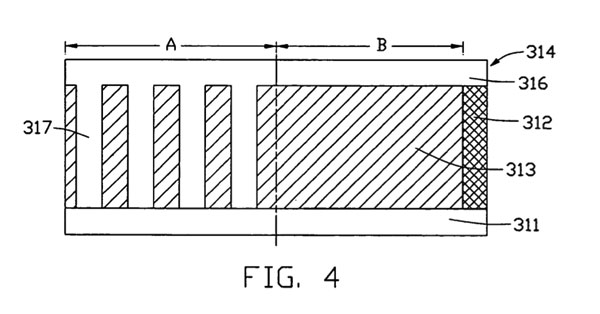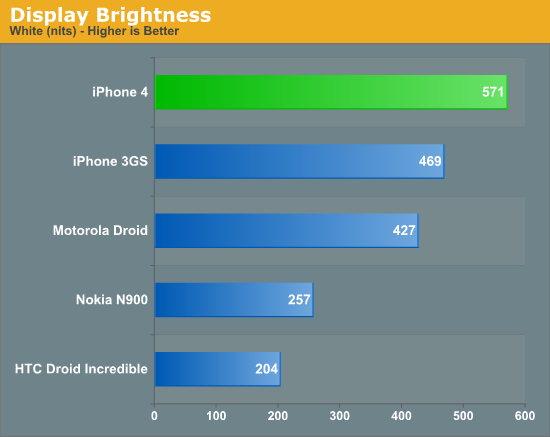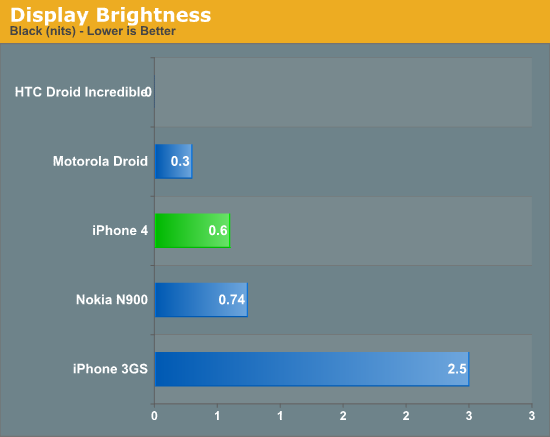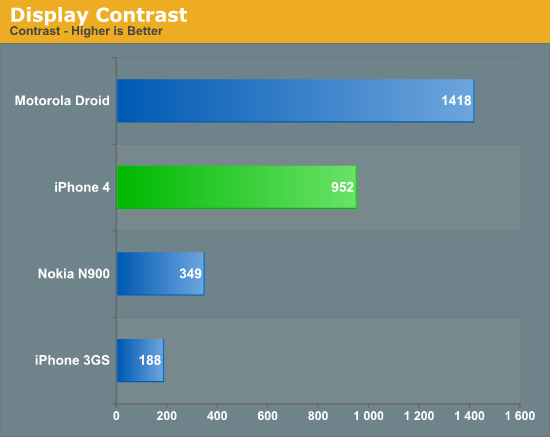Apple's iPhone 4: Thoroughly Reviewed
by Brian Klug & Anand Lal Shimpi on June 30, 2010 4:06 AM EST- Posted in
- Smartphones
- Apple
- iPhone 4
- Gadgets
- Mobile
More Display
It's obvious how Apple settled on 960x640; it's four times the resolution of the previous iPhones. However, instead of decreasing text size, iOS 4 scales appropriately, and the size of everything remains the same. The result is that there are small details everywhere that pop out. Apple's icons on the home screen are the first that really pop out, and new iOS 4 optimized applications will bring that increased detail as developers add higher resolution artwork.
The display panel itself uses a subset of IPS (In Plane Switching) display technology called Fringe Field Switching (FFS). Where IPS switches the crystal polarization in the plane of the display with two opposing electrical substrates composed of semi opaque metals (which decreases transmission and viewing angles), FFS uses considerably less metal by arranging the electrodes in a comb like structure.

See that - it almost looks like a comb. Or an impulse train. Or Dirac comb. So many combs.
The result is that there's considerably less metal in back and in front of the pixel, resulting in much higher transmission of light through the display, and higher brightness for a given backlight level. Using FFS to drive pixel switching is critical here because of the high dot pitch in the iPhone 4's display.
The other interesting difference between iPhone 4's retina display and previous displays is that the digitizer is in optical contact with the display itself. There's no longer an air gap, and as a result, no longer any opportunity for dust to gradually work its way inbetween. Over time, I've noticed a few dust specks creep in on my 3GS, it does happen. The digitizer and display panel are essentially laminated together. The added benefit is that fewer material interfaces results in fewer internal reflections - think the "super" in Super AMOLED but applied to TFT. That's what Apple has done here.
Apple is using Corning's Gorilla glass which touts hugely increased scratch resistance and robustness. Both the front and back of the iPhone 4 are that same type of glass. I've noticed a few superficial scratches (called sleeks) that have appeared on the back, but really the true test will be how the phone looks after 6 months in the pocket. It's interesting that the iPhone capacity markings have disappeared from the back of the phone - no doubt this was done so Apple could make one part and one part only for each color.
The rest of the details are in the specifications. Apple advertises increased brightness of 500 nits and a contrast ratio of 800:1. We measured, and our iPhone 4 exceeded specs at 571 nits and just under 1000:1 contrast ratio.



Note that the HTC EVO 4G is missing as Anand has it, but it's on its way to me. As soon as I get it, I'll measure display brightness, black point, and contrast and update these results. In addition, the HTC Droid Incredible (and thus Nexus One) contrast is effectively infinity by the way we calculate, due to pixels being completely turned off in the black state. In addition, I'm led to believe that the AMOLED's PenTile grid throws off our numbers when measuring brightness. I've run and rerun this test, it keeps coming up that way.
Next to the iPhone 4, the 3GS display really shows its age. It leaks light when displaying black, with an absurdly high black point of nearly 3 nits. Just looking at the lock screen on the iPhone 4 next to the 3GS it's readily apparent how much better blacks are. iPhone 4 easily bests the 3GS but still isn't quite as contrasty as the Incredible or Nexus One AMOLED displays, or the IPS in the Motorola Droid. You do get higher resolution and brightness, however, but nothing is free.
Going from the iPhone 4's display back to the 3GS is pretty painful, but going back to even relatively high dot pitch displays on the desktop is painful as well. Even on the "high resolution" MacBook Pro with 1680x1050 display, displaying an iPhone 4 screenshot at native resolution uses up 91% of the height. If there's one thing I hope the iPhone 4 display does, it's generate demand for 300 PPI level desktop displays - the era of 110 PPI displays being the norm needs to end now.










270 Comments
View All Comments
JAS - Wednesday, June 30, 2010 - link
AT&T recently upgraded its 3G network in New York City. So, the improved wireless connection experienced with the iPhone 4 might be coincidental.http://news.cnet.com/8301-1035_3-20009134-94.html
John Sawyer - Thursday, July 1, 2010 - link
You mean, "might NOT be coincidental"?John Sawyer - Thursday, July 1, 2010 - link
A very large part of the problem between ATT and the iPhone prior to model 4, has been a weird interaction between the two, rather than being due to just one or the other. I don't know which party is more to "blame" for not having addressed this problem, but since the iPhone 4, and non-iPhones, experience much fewer problems with ATT's signal, I suspect Apple and the previous iPhone designs are more to blame, and ATT has allowed itself to take the brunt of it.Dennis Travis - Wednesday, June 30, 2010 - link
Another Outstanding review. So much detail. The part on the Antenna was great. Answered any questions I had about the iPhone 4.Thanks so much.
mongo lloyd - Wednesday, June 30, 2010 - link
"If you're married to Android, in the next 6 - 12 months we should see feature parity from the competition."I must be mad then, because I'd say there are Android smartphones out there that match, or even surpass the iPhone 4's features (especially software-wise), apart from battery life and the high-res screen (but the difference isn't massive between 600x960 and 480x800 or 480x854, plus you have the TFT vs (S)AMOLED pros and cons).
mongo lloyd - Wednesday, June 30, 2010 - link
It is a nice screen though, I must say.solipsism - Wednesday, June 30, 2010 - link
Buying and using nearly every new smartphone I can't say that Android beats iOS in any consumer way expect for the anemic notification system found on iOS, but while Android is pretty decent, it's still a far cry from WebOS. I haven't gotten the push for Froyo yet, have they finally fixed copy/paste on Android to?I see Android (and other) smartphones being in trouble in this next year against the iPhone 4. They will need to compete against the iPhone 4's display but at the risk of battery life, which they already do poorly in (despite the iPhone getting a bad rap). Unless Froyo has brought about some dynamic power management changes I don't think see other smartphones being as competitive as they would have been otherwise.
Spoelie - Wednesday, June 30, 2010 - link
In GSMarena's preview of iOS4, there is a whole list of features that iOS4 does not do that Android does. This is not a stab at iOS4, but it does validate the conclusions Anand makes and it proves that you can't really make blanket statements like "can't say that Android beats iOS in any consumer way". It just depends how much you value those kind of features. The list reads like this:* No Flash support in the web browser
* No true multitasking for all applications
* iOS4 for iPhone 3G has limited new feature set
* Poor performance on iPhone 3G
* No quick toggles for Wi-Fi, Bluetooth or 3G
* No social networking integration
* No info widgets on lockscreen or homescreen
* SMS tones are still not customizable
* No mass mark emails as read
* No proper file browser or access to the file system
* No USB mass storage mode
* No vibration feedback when touching the screen
* No Bluetooth file transfers to other mobile phones
* Contacts lack a swipe-to-delete or mass delete feature
* No SMS/MMS delivery notifications
* No smart dialing (but Spotlight is a somewhat of a substitute)
* No DivX or XviD video support and no official third-party application to play that
* The whole iPhone is too dependent on iTunes - you cannot add the same type of content (video, photos, apps) to the phone from two computers, a regular file management interface would have been much better
Again, not a stab at iOS4, just to point out the different markets.
FATCamaro - Wednesday, June 30, 2010 - link
I think all but 3 in your list are design choices rather than missing features. The only things that seem like features would be...* No info widgets on lockscreen or homescreen
* No SMS/MMS delivery notifications
* No mass mark emails as read
Griswold - Wednesday, June 30, 2010 - link
Theres no difference for the enduser between design choices and missing features - if it doesnt do what you want or need it to do, its not the right phone. That said, the feature set of android is much richer, but not everyone wants or needs that... apparently. Doesnt change the fact that android does beat iOs in many ways.